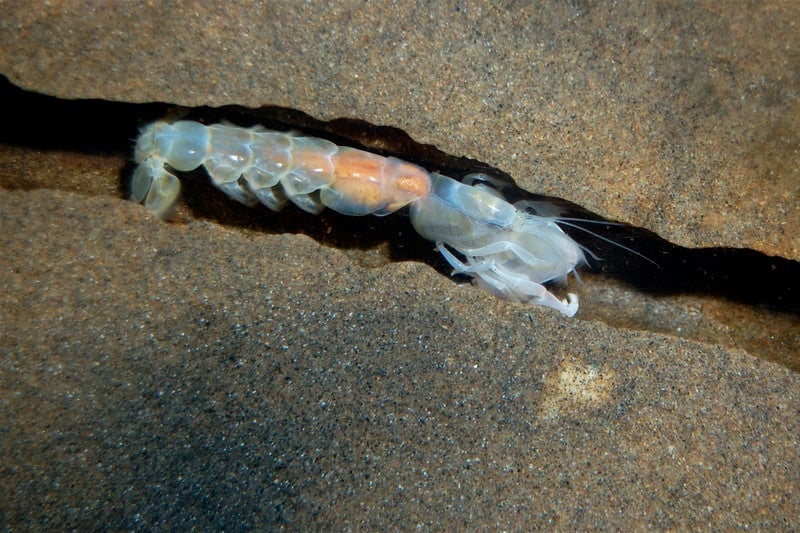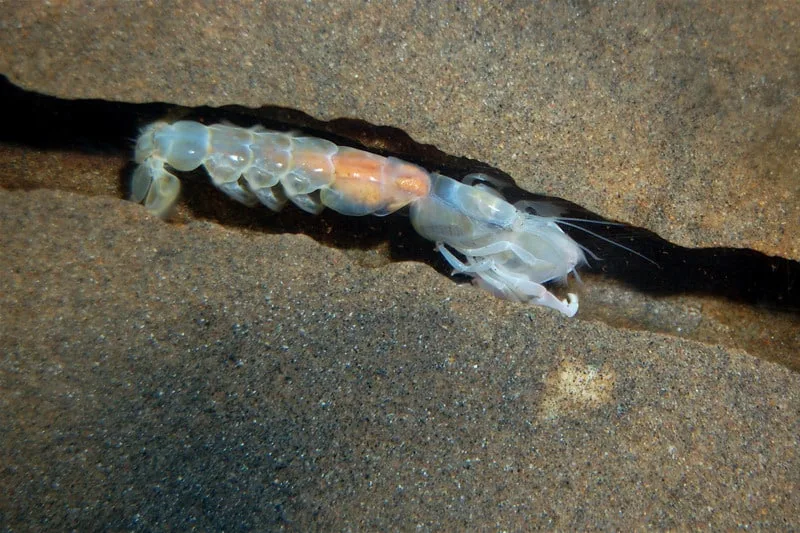Our expert-vetted content is grounded in current scientific publications, yet we acknowledge science’s ever-evolving nature. Read our full editorial and disclosure policy.
Introduction
As a child, I often joined my father on fishing trips. Our days typically began with pumping sandprawns to use as bait. The sight of these prawns always made me squirm. I distinctly recall my confusion at seeing them with only one large claw, mistakenly assuming the other was missing. I remember the females, distinguishable by their bright orange-pink clusters of eggs. Unbeknownst to my younger self, my future would reconnect me with these creatures once more.
When I began my Honours degree in Marine Biology, I delved deeper into the world of the sandprawn. Through my studies of this unassuming marine species, I grew to appreciate their unique role in southern African coastal ecosystems.
In this article, we explore the role that sandprawns play in maintaining coastal ecosystem health, especially amidst rising global environmental challenges.
Earth’s Changing Face: The Global Change Phenomenon
Shifts in Earth’s Natural Processes
Climate change is causing shifts in our Earth’s chemistry and biogeochemical process which is posing a serious threat to species worldwide. Biogeochemical processes refer to natural cycles between living systems and the physical environment. These processes involve the biological (bio-), geological (geo-), and chemical aspects of the environment. The main purpose of biogeochemical cycles is to transform, transport, and recycle substances like carbon, nitrogen, oxygen, phosphorus, sulfur, and water within our environment.
Climate Change Stressors
A significant consequence of climate change is the shift in the number and distribution of species across our planet. A global change stressor is any factor that is introduced or intensified by global changes and has the potential to negatively impact ecosystems, species, and human societies.
Increased temperature is one climate change stressor that has the potential to trigger profound physiological, behavioural and interactional changes to species in our ecosystems. The extent of these stressors has the potential to negatively impact species adaptability, disrupt community structures and diversity, and in severe situations, cause species extinction.
Coastal Ecosystems: Vibrant but Vulnerable
Coastal ecosystems are some of the Earth’s most productive habitats. They are also paramount in regulating climate and the production of organic matter as a food source for other animals.
Shallow-water marine ecosystems, like estuaries, mangroves and saltmarshes, are particularly celebrated for their rich biodiversity. When visiting these ecosystems it is easy to assume that little happens inside the sandy sediment beneath your feet. But in fact, these ecosystems are dominated by benthic infauna and epifauna.
What are benthic infauna and epifauna?
| Classification | Description | Examples | Role in Ecosystem | |
| Benthic Infauna | Organisms that live within the sandy sediment and burrow into it. | Worms, Clams | Carbon cycling, sediment redistribution, water quality maintenance | |
| Benthic Epifauna | Organisms that reside on the surface of the sandy sediment. | Crabs, Starfish | Carbon cycling, sediment redistribution, water quality maintenance |
Roles in Ecosystem Explained
- Carbon Cycling: Think of it like a big circle where carbon moves from the air to plants through a process called photosynthesis. When animals breathe out, or plants decay, or we burn fuels, this carbon goes back into the air. Creatures living in the sand help this circle by eating stuff, breaking it down, and moving carbon around.
- Sediment Redistribution: Some creatures living in the sand, like worms, move around and mix the sand as they dig. This mixing helps increase oxygen and spread nutrients and small particles in the sand, making it habitable for other organisms.
- Water Quality Maintenance: Creatures living on and in the sand eat waste and tiny organic bits. By doing this, they help clean the water, making it less cloudy and preventing harmful overgrowth of algae.
Meet the Sandprawn: An Ecosystem Engineer

The common sandprawn, scientifically known as Callichirus kraussi, is a marine crustacean found primarily in the intertidal zones along the southern African coast. These prawns are well adapted to sandy environments, with slender bodies that allow them to burrow and navigate through soft sediment with ease. They are described by a unique appearance, typically having one larger claw.
What’s so fascinating about sandprawns is their evolutionary ability to combat low oxygen states in the sandy sediment. They exhibit a unique behaviour of beating their pleopods, their legs, to flush their burrows with oxygen-rich waters. This enables them to breathe even under low oxygen. And when oxygen levels become critically low, these creatures can ingeniously switch to anaerobic respiration.
Beyond survival, sandprawns are respected ecosystem engineers. They indirectly structure ecological communities by forming extensive burrow systems. These burrows provide habitats for other organisms and influence the nutrient cycle, production of food and sediment quality. Their role is so integral that they can significantly dictate the ecosystem’s response to disturbances, like climate change.
Sandprawn Roles in the Ecosystem Explained
- Sediment Bioturbation: Sandprawns are renowned burrowers. As they tunnel and dig into the sediment, they facilitate a process called bioturbation. This is the mixing and turning of sediment, which redistributes particles and nutrients within sediment layers. This action can significantly affect the physical and chemical dynamics of the sediment, enhancing oxygen penetration, nutrient recycling, and overall sediment health.
- Water Quality Maintenance: One of the most significant discoveries about the sandprawn is its ability to combat eutrophication by filtering coastal waters. Eutrophication refers to the excess nutrients in the water, which often leads to dense algal blooms. These blooms deplete oxygen in the water, which can be harmful to marine life. The sandprawn plays a vital role in controlling this by feeding on microscopic algae, thus preventing the excess growth of these algae in water bodies. Their burrowing activity aids in filtering the water, removing algae and improving water quality.
- Food Chain: As a part of the marine food web, sandprawns serve as a food source for various predators, including fish. This makes them an essential link in trophic relationships, ensuring energy flow and nutrient transfer through different marine species.
Balancing Act: Temperature, Nutrients, and Relationship With Other Species
The sandprawn’s environment is intricate, and influenced by various factors. With rising coastal water temperatures worsening low-oxygen conditions caused by excess nutrients, the interplay between these factors becomes critical.
In this complex scenario, sandprawns have demonstrated a remarkable ability to maintain or even enhance high-oxygen conditions within the sediment. Their behaviour significantly contributes to sediment oxygenation, thereby reducing the potential for low-oxygen or no-oxygen conditions caused by climate change stressors.
A Delicate Dance: Predicting the Sandprawn’s Response
The study of the sandprawn’s response to climate change is ongoing. But from what we already know, we can speculate that moderate temperature increases could enhance sandprawns’ metabolic activity, prompting a higher food intake and potentially increasing sediment bioturbation. This relationship suggests that a balanced increase in nutrients could support the sandprawns’ heightened metabolism, ultimately benefiting the entire ecosystem.
Final Thoughts On Sandprawns In Coastal Ecosystems
Understanding the role of these ecosystem engineers is important in recognizing the impacts of climate change drivers like warming and increased nutrients in marine ecosystems. Future strategies must focus on conservation efforts that safeguard sandprawn habitats, promote research into the nuanced interactions of climate change factors, and initiate measures to reduce human-induced stressors on coastal ecosystems.
There is no doubt that sandprawns are indispensable allies in our quest to maintain ecological balance in our increasingly threatened coastal habitats. Their resilience and ecological engineering are vital cogs in the wheel of coastal ecosystem functionality.
If you enjoyed this article, or have any questions regarding sandprawns, please leave a comment below. I will gladly answer your questions.
You May Also Like
- Meet The Bizarre Fish Living in the Deepest Depths of the Ocean
- Top 10 Ugly Fish in The World
- The Great White Shark: Apex Predator of the Ocean
- Top 10 Cutest Fish in the World
References
- Olivia, Venter., Deena, Pillay., Kervin, D, Prayag. (2020). Water filtration by burrowing sandprawns provides novel insights on endobenthic engineering and solutions for eutrophication. Scientific Reports, 10(1), 1913-.
- P, Nel., George, M., Branch. (2013). Assessment of the abundance and distribution of burrowing sandprawns and mudprawns (Callichirus and Upogebia species) in Langebaan Lagoon, South Africa. African Journal of Marine Science, 35(2), 195-208.
- Rachel, Wynberg., George, M., Branch. (1994). Disturbance associated with bait-collection for sandprawns (Callianassa kraussi) and mudprawns (Upogebia africana): Long-term effects on the biota of intertidal sandflats. Journal of Marine Research, 52(3), 523-558.
Join our Forum for free today!

- Surprise Hippo Attack on Three Lions - July 21, 2024
- USA’s Best Wildlife Conservation Success Stories - July 14, 2024
- The Incredible Bird with Sunflower Eyes - July 13, 2024

